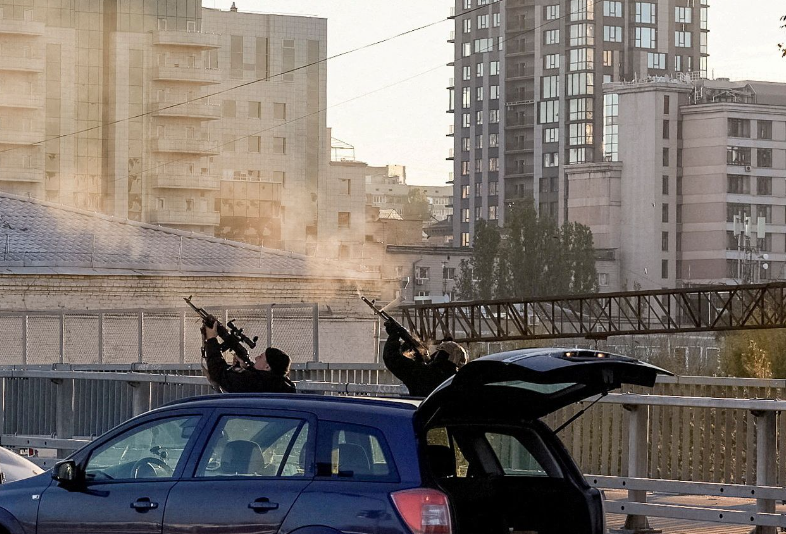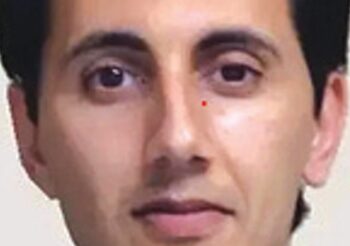December 16,2022

TOYLAND — Ukrainian President Volodymyr Zelensky recently posed with this Iranian-made Shahed-136 drone that made an unplanned crash-landing.
Iran denies selling drones to Russia since it invaded Ukraine and has repeatedly asserted that Ukraine has provided no evidence of any such deliveries.
Iranian Defense Minister Mohammad-Reza Ashtiani recently said talk of such Iranian deliveries is based on nothing but “baseless statements and rumors.”
by Warren L. Nelson
The Islamic Republic is almost daily denying it is selling its drones to Russia while Ukraine is almost hourly announcing that it has shot down another Iranian drone.
Ukraine asserts that it is shooting down about 70 to 80 percent of the drones Russia sends into its airspace, but enough have gotten through and struck Ukrainian power plants and waterworks that they are seriously eroding the daily lives of the Ukrainian people which appears to be the whole point of Russia’s purchase of the Iranian drones. Moscow seems to be counting that the drone damage will make Ukrainians so miserable this winter that they will sue for peace.
But, so far, the drones have only made the Ukrainians furious with Iran as well as with Russia. President Volodymyr Zelensky has even made a point of posing beside one of the Iranian drones that crash landed in a Kyiv street.
The drones fly low and slow and are not all that hard to shoot down. Ukrainian troops with rifles are even shooting them out of the sky.
Ukraine has regularly cited Iran’s drone sales to Russia and castigated the Iranian regime in an obvious effort to embarrass it and try to lead it to stop the sales. Zelensky has accused Iran of causing the war to last longer by its sales. A major concern of Europe is that the war not last long.
The Islamic Republic seems to be having some second thoughts about its weapons deal with Russia. Tehran apparently assumed that its drone sales would convince Moscow that it was a reliable and useful ally. And that may well be true. But Tehran now realizes that much of the rest of the world sees it as interfering in a part of the world far from its interests. And much of the Iranian public sees it as selling the Iranian soul to Russian killers.
Tehran made outright denials about having sold any drones to Russia for 54 days, when it concluded that no one believed what it was saying. The Islamic Republic then shifted its line, with Foreign Minister Hossein Amir-Abdollahian saying that Iran had only provided “a small number” of drones to Russia in the days before the war began. Ukraine promptly replied that it had found manufacturing dates on parts of the drones showing they were made since the February invasion. (One week before Abdollahian’s statement, Iran’s ambassador to the UN, Amir-Saeed Iravani, told the UN Security Council Iran had never sold any weapons to Russia, not even before the war.)
What’s more, although the regime has boasted to the Iranian public about how it has designed and built the drones entirely domestically, the Ukrainian government says there are very few Iranian parts in Iran’s Shahed-136 drones the type most commonly used by Russia. The parts come from all over the world more than 30 companies in Europe, the United States, Canada, Japan, China, even Ukraine, Israel and Russia. They are off-the-shelf parts that can be bought commercially from shops and then shipped to third countries without triggering sanctions and forwarded to Iran.
The Wall Street Journal reported November 17 that Ukrainian technicians had gathered more than 200 parts from Shahed-136s shot down or crash-landed in Ukraine and found about half the parts were made by US companies and a third by Japanese firms.
The engines used in another Iranian drone sold to Russia, the Mohajer-6, are an Austrian design that is used in many small aircraft all around the world. The publicity given the Russian use of the drones has focused a great deal of attention on the engines and revealed something police had not noticed before. More than 150 of those engines have been stolen off small planes all over Europe in recent years. Police had recorded the thefts individually but not put them together until the publicity given their use on Iran’s Mohajer-6, which is an unarmed intelligence-gathering drone.
The Shahed-136 is assembled at the HESA aircraft factory near Esfahan. The drone weighs only about 200 kilograms (440 lbs.), one-fifth of which is the explosive warhead. It cruises at around 100 mph (160 kph). The drones are estimated to cost only $20,000 to $30,000 apiece. It was first used against Ukraine September 13.
Maj. Gen. Yahya Rahim Safari, military assistant to the Supreme Leader, said October 18 that 22 countries are seeking to buy various Iranian-made drones because they are of such high quality. In a televised address October 22, President Raisi said, “Until recently, our military industry did not even produce barbed wire.” But now, he said, all that has changed and world leaders whom he met at the UN in September said to him, “Your industry is more advanced. It is different from the rest of the world.”
Some military analysts suspect Safari is telling the truth about 22 countries seeking Iranian drones, but judges the interest is based on their cheapness and the fact that many Western countries won’t sell drones to them.
US officials announced in November that US intelligence had learned Iran had agreed not only to sell Russia more drones but also to begin delivering small ballistic missiles. In December, John Kirby, spokesman for the US National Security Council, said Washington had seen more drone deliveries to Russia but had no evidence of any ballistic missiles being delivered, prompting speculation that Iran might be having more doubts about the political costs of delivering major weapons to Russia.
Mikhailo Podolyak, a Ukrainian presidential staffer, said December 6 that Iran had delivered 2,400 drones to Russia since August, indicating that Iran has a major production capability for the weapons. Podolyak said Ukraine believed Russia had offered to pay for the equipment in part by sending its own “cut-throats” to Tehran to help the Islamic Republic suppress the ongoing protests. That remains unconfirmed.
More than three months after Iran began supplying drones to Russia, Iranian Foreign Minister Abdollahian yet again denied on December 3 that Iran was sending drones to Russia. He said the West was making up this falsehood for the sole purpose of legitimizing its own deliveries of weapons to Ukraine. That was an odd allegation given that few are criticizing Western arms deliveries to Ukraine except Russia and Iran.
Meanwhile, Ukrainian news reports in late November said Ukrainian military strikes on Russian bases in Crimea had killed 10 Iranians who had been deployed there to help the Russians pilot the drones toward targets in Ukraine. There has not as yet been any confirmation of this claim by Western officials, though the US has said it knows Iranian military officers have been sent to Crimea.
The EU in mid-October issued a package of sanctions against three Iranian generals it said were linked to Iran’s delivery of drones to Russia. The sanctions froze any assets they have in Europe and barred the issuance of visas to them by EU member states.

POT SHOTS — Ukrainians using ordinary rifles have claimed to have shot down many Iranian-built drones flying over their cities.

























